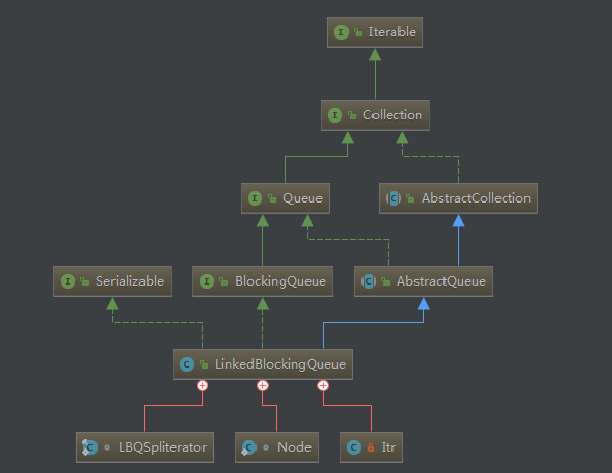前面学了 Executor 框架,线程池参数,以及基本线程池的使用,今天来学学面试问的核心 – 线程池中的队列队列。在聊聊 java 线程池一文中,简单介绍了几种常用的阻塞队列,但都是一笔带过,接下来的文章会着重讲线程池中的队列。
由于线程池中使用的队列有多种,接下来会分多篇文章进行学习。
LinkedBlockingQueue队列:
首先我们先看看下图
从上图我们可以很清楚的看到 LinkedBlockingQueue 类中关系,Collection 接口我想大家都很熟悉,平时我们在开发中最常用的 List,Set 顶层也是该接口。按照 java 的语言风格,基本是不断抽象出公共接口,子接口或抽象类则在原有的基础上提供独有的方法。
而 LinkedBlockingQueue 是 BlockingQueue 的实现类,那我们需要先看看 BlockingQueue 提供了哪些方法。
public interface BlockingQueue<E> extends Queue<E> {
//将对象塞入队列,如果塞入成功返回true, 否则返回false。
boolean add(E e);
//将对象塞入到队列中,如果设置成功返回true, 否则返回false
boolean offer(E e);
//将元素塞入到队列中,如果队列中已经满了,
//则该方法会一直阻塞,直到队列中有多余的空间。
void put(E e) throws InterruptedException;
//将对象塞入队列并设置时间
//如果塞入成功返回 true, 否则返回 false.
boolean offer(E e, long timeout, TimeUnit unit)
throws InterruptedException;
//从队列中取对象,如果队列中没有对象,
//线程会一直阻塞,直到队列中有对象,并且该方法取得了该对象。
E take() throws InterruptedException;
//在给定的时间里,从队列中获取对象,
//时间到了直接调用普通的poll方法,为null则直接返回null。
E poll(long timeout, TimeUnit unit)
throws InterruptedException;
//获取队列中剩余长度。
int remainingCapacity();
//从队列中移除指定的值。
boolean remove(Object o);
//判断队列中包含该对象。
public boolean contains(Object o);
//将队列中对象,全部移除,并加到传入集合中。
int drainTo(Collection<? super E> c);
//指定最多数量限制将队列中对,全部移除,并家到传入的集合中。
int drainTo(Collection<? super E> c, int maxElements);
}
看完上面的代码,我们基本知道了 LinkedBlockingQueue 队列有什么方法,简单说就是实现 BlockingQueue 接口的提供的方法。LinkedBlockingQueue 源码中包含很多知识点,比如:显示锁和线程间通信的方式。几天前大佬分析过一篇文章里就讲了线程通信的 Condition 接口,锁的话也稍微讲了些,这里就默认都会的情况下来看。
/** 显示锁,在将对象从队列中取出时加的锁 */
private final ReentrantLock takeLock = new ReentrantLock();
/**线程间通信,从队列中取对象,如果队列为空时,就阻塞 */
private final Condition notEmpty = takeLock.newCondition();
/** 显示锁,在将对象塞入队列时加的锁 */
private final ReentrantLock putLock = new ReentrantLock();
/**线程间通信,塞对象入队列,如果队列满时时,就阻塞*/
private final Condition notFull = putLock.newCondition();
notEmpty 对象在队列从取出值时,如果队列中没有值了,那线程将会堵塞,等待有值进入队列后唤醒线程取值。
notFull 对象对象,如果塞值进队列时,队列已经满了,那线程将会堵塞,直到队列中值被消费,唤醒线程去塞入值。
LinkedBlockingQueue 中有多种入队方法,下面我们来对比下几种入队方式的优劣势:
| 入队方法 | 是否阻塞 | 适合队列 |
|---|---|---|
| offer | 否 | 有界队列 |
| put | 是 | 都可以 |
其实入队方法还要个 add 的,但是它还是调用 offer 的入队方法,这里就不介绍。offer 入队方式比较适合有界队列,offer 在队列满的时候,入队失败会返回 false,而 put 的方法在队列满的时候,会将线程阻塞。
下面我们来看看入队操作的源代码实现:
put 方式:
public void put(E e) throws InterruptedException {
//对象为空时抛出异常
if (e == null) throw new NullPointerException();
int c = -1;
//节点
Node<E> node = new Node<E>(e);
//入队锁
final ReentrantLock putLock = this.putLock;
//原子类,用于比较是否超过队列边界
final AtomicInteger count = this.count;
//显示锁,上可中断锁
putLock.lockInterruptibly();
try {
//判断队列是否已经满,满了就乖乖阻塞
while (count.get() == capacity) {
notFull.await();
}
//入队操作
enqueue(node);
//自增(线程安全)
c = count.getAndIncrement();
//判断队列是否超过边界
if (c + 1 < capacity)
notFull.signal();
} finally {
//释放锁
putLock.unlock();
}
//唤醒其他阻塞的线程
if (c == 0)
signalNotEmpty();
}
offer 方式,这个方式有两种不同的方法,这里只介绍一种:
public boolean offer(E e) {
//对象为空时抛出异常
if (e == null) throw new NullPointerException();
//原子量,用于自增
final AtomicInteger count = this.count;
//判断队列是否已经满了,满了直接返回 false
if (count.get() == capacity)
return false;
int c = -1;
Node<E> node = new Node<E>(e);
//入队锁
final ReentrantLock putLock = this.putLock;
//显示锁
putLock.lock();
try {
//判断队列是否已经满了
if (count.get() < capacity) {
//入队
enqueue(node);
//自增
c = count.getAndIncrement();
//入队后再判断队列是否已满
if (c + 1 < capacity)
notFull.signal();
}
} finally {
//解锁
putLock.unlock();
}
//唤醒消费线程
if (c == 0)
signalNotEmpty();
return c >= 0;
}
入队方法写完,接下来看看出队的方法:
阻塞出队的方法:
public E take() throws InterruptedException {
E x;
int c = -1;
final AtomicInteger count = this.count;
final ReentrantLock takeLock = this.takeLock;
//可中断锁
takeLock.lockInterruptibly();
try {
//当队列为空时,阻塞等待
while (count.get() == 0) {
notEmpty.await();
}
//出队操作
x = dequeue();
//自减
c = count.getAndDecrement();
//判断队列中是否有对象,有就唤醒之前阻塞的线程
if (c > 1)
notEmpty.signal();
} finally {
//解锁
takeLock.unlock();
}
if (c == capacity)
signalNotFull();
return x;
}
非阻塞出队的方法:
public E poll() {
final AtomicInteger count = this.count;
//队列为空时,返回空
if (count.get() == 0)
return null;
E x = null;
int c = -1;
final ReentrantLock takeLock = this.takeLock;
//加锁
takeLock.lock();
try {
//判断队列中是否有对象
if (count.get() > 0) {
//出队操作
x = dequeue();
//自减
c = count.getAndDecrement();
//唤醒其他出队操作阻塞的线程
if (c > 1)
notEmpty.signal();
}
} finally {
//解锁
takeLock.unlock();
}
//唤醒其他队列满时阻塞的线程
if (c == capacity)
signalNotFull();
return x;
}
总得来说这篇还是很简单的,认真看一下就懂的了。上面涉及到的队列的数据结构就不用说了吧?后面会继续出线程池相关队列的文章,肯定会比这一篇难。
有兴趣的同学欢迎关注公众号:

最后
以上就是舒服发带最近收集整理的关于面试准备 -- 线程池队列LinkedBlockingQueue详解的全部内容,更多相关面试准备内容请搜索靠谱客的其他文章。

![[转发]线程池的使用场景以及java中ThreadPoolExecutor类的讲解](https://file2.kaopuke.com:8081/files_image/reation/bcimg7.png)






发表评论 取消回复